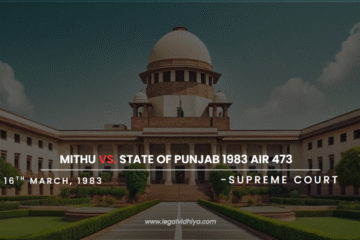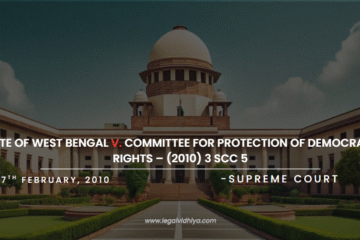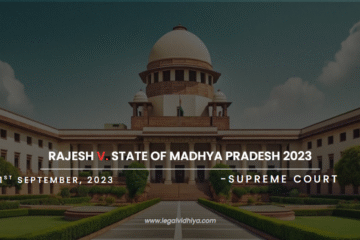
Narain vs. Superintendent, Central Jail, New Delhi AIR 1971 SC 178
| Case Name: | Narain Vs. Superintendent, Central Jail, New Delhi |
| Equivalent Citation: | AIR 1971 SC 178 |
| Date of Judgement: | 11 September, 1970 |
| Court: | Supreme Court of India |
| Case no: | Writ Petition No. 330 of 1970 |
| Case type: | Writ Petition (Civil) |
| Petitioner: | Raj Narain |
| Respondent: | Superintendent, Central Jail, New Delhi |
| Bench: | M. Hidayatullah (CJ), J.M. Shelat, V. Bhargava,G.K. Mitter, C.A Vaidyialingam, A.N Ray, I.D Dua |
| Referred: | Writ of Habeas corpusJudicial remandThe Code of Criminal Procedure, 1973 |
FACTS OF THE CASE:
- On August 20, 1970, Mr. Raj Narain M.P. was detained on the basis of a warrant issued by the City Magistrate of Lucknow and was arrested in accordance with Sections 107 and 117 of the Code of Criminal Procedure, 1973.
- A writ of habeas corpus was filed in the Supreme Court, and on August 22, 1970, this Court ordered him to be transferred to Tihar Central Jail in Delhi for his appearance before the court.
- Mr. Raj Narain’s original detention was set to expire on August 28, 1970, as per the City Magistrate’s directive. Given that the detention was set to expire at midnight on that day, the Superintendent of Central jail in Delhi requested instructions from the court at 4. P.m.
- The Magistrate court ordered that in the situation that has arisen, Mr. Narain remanded back to the custody to which he belonged, that he be taken to Uttar Pradesh, if so desired to be produced before the Court at the next hearing, and that if no fresh remand orders were received by midnight, the Mr. Narain should be released at midnight.
- The Superintendent of Tihar Jail was notified the following day by telegraphic message from the City Magistrate of Lucknow that Mr. Narain had been ordered to be held in judicial custody till September 10, 1970
- Mr. Raj Narain filed a habeas corpus petition, claiming that the remand order was conveyed to him on the morning of August 29th, and so his detention after midnight on August 28th was unlawful and unsupported by any remand order.
ISSUES RAISED:
The main issues in this case are stated below:
- The question is whether Mr. Raj Narain’s detention became unlawful at midnight on August 28, 1970.
- Is the defendant’s physical production required for judicial remand?
CONTENTIONS OF THE PETITIONER:
- Mr. Raj Narain’s attorney cited the case In re Venkataraman, 49 Cri.L.J. 41, in which it was determined that a magistrate committed an illegality by remanding a prisoner without first bringing him, asking him if he wanted a lawyer, or giving him a chance to show cause why he shouldn’t be kept in custody any longer.
- Furthermore, because he was remanded behind his back, his remand is illegitimate, and he is entitled to be released.
RATIO DECIDENDI (5:2)
- The majority judgement was delivered by M. Hidayatullah (CJ) on behalf of him and V. Bhargava, G.K. Mitter, A.N Ray, and I.D Dua. According to the majority opinion in this case, Mr. Raj Narain’s detention is legitimate and he is not entitled to release based on his new petition.
- C.A Vaidyialingam (J) delivered the dissenting opinion on behalf of him and J.M. Shelat. According to the dissenting view, the petitioner’s imprisonment in the Tihar jail, after the midnight on August 28, 1970, on the authority of illegitimate remand order is equally illegal. Therefore, the petitioner should be released immediately.
JUDGEMENT ANALYSIS:
Seven Supreme Court of India Judges – M. Hidayatullah (CJ), J.M. Shelat, V. Bhargava, G.K. Mitter, C.A Vaidyialingam, A.N Ray, and I.D Dua – sat on a bench to hear the matter and render a decision. On September 11, 1970, the Court issued its ruling with a majority of 5 judges.
M. Hidayatullah, India’s then-chief judge, read the majority opinion. The court, while delivering the judgement, highlighted that the facts here are different from the case cited by the petitioner’s counsel. Mr. Raj Narain did not seek bail or representation by counsel. He complained about nothing except his detention, which he claimed as unlawful because he was not produced before the Magistrate.
The Supreme Court ruled that if the Magistrate extends the duration of detention and communicates the order to the person in the prison’s direct care, with notice to this court and the prisoner, then this is sufficient to validate the magistrate’s order.
The court further observed that expecting more of the magistrate under section 344 of the Code of Criminal Procedure under such circumstances would be unreasonable because the law does not allow for unreasonable expectations.
The Apex court therefore concluded that Mr. Narain is being detained on appropriate remand by the magistrate and that there is no sufficient justification for his release in this current matter.
C.A Vaidyialingam and J.M. Shelat, on the other hand, were the dissenting voices in this case. According to the dissenting view, the petitioner’s imprisonment in the Tihar jail, after the midnight on August 28, 1970, on the authority of illegitimate remand order is equally illegal. Therefore, the petitioner should be released immediately.
CONCLUSION:
The case Narain vs. Superintendent, Central Jail, New Delhi AIR 1971 SC 178, which concerns judicial remand under the Code of Criminal Procedure, is significant and historic.
The question in this case whether the offender should be physically produced for judicial remand. According to 167 of the Code of Criminal Procedure, no magistrate shall sanction detention in any custody unless the accused is produced before him. If there is any doubt about whether the accused appeared before the magistrate, his signature on the order authorizing detention may be used to verify his appearance. The main objective of Section 167 of Cr.P.C. is to provide the accused a fair chance to be heard before making any decision. The accused may have valid reasons not to extend his remand, but cannot say so unless he appears in person before the magistrate.
However, the Supreme Court has relaxed this rule under certain conditions, stating that if the accused cannot be produced in person due to illness or if he is wanted in two different courts in two different districts on the same day, remand may be granted in his absence. This is an exemption to the general norm set down in Cr.P.C. section 162 (2) (b).
The present matter comes under the exceptional category. Mr. Raj Narain was to appear before the Supreme Court, but his name was not listed, therefore he could not appear. On August 28, 1970, his judicial remand was scheduled to expire. Since the accused’s physical appearance was impossible, the magistrate court acted lawfully and performed as effectively as he could under such circumstances. Therefore, the magistrate court’s order is valid.
REFERENCES:
- https://indiankanoon.org/doc/1666940/
- https://www.legalauthority.in/judgement/raj-narain-vs-supdt-central-jail-new-delhi-34804
- https://www.lawfinderlive.com/Articles-1/Article152.htm
written by Saheli Naha intern under legal vidhiya




0 Comments